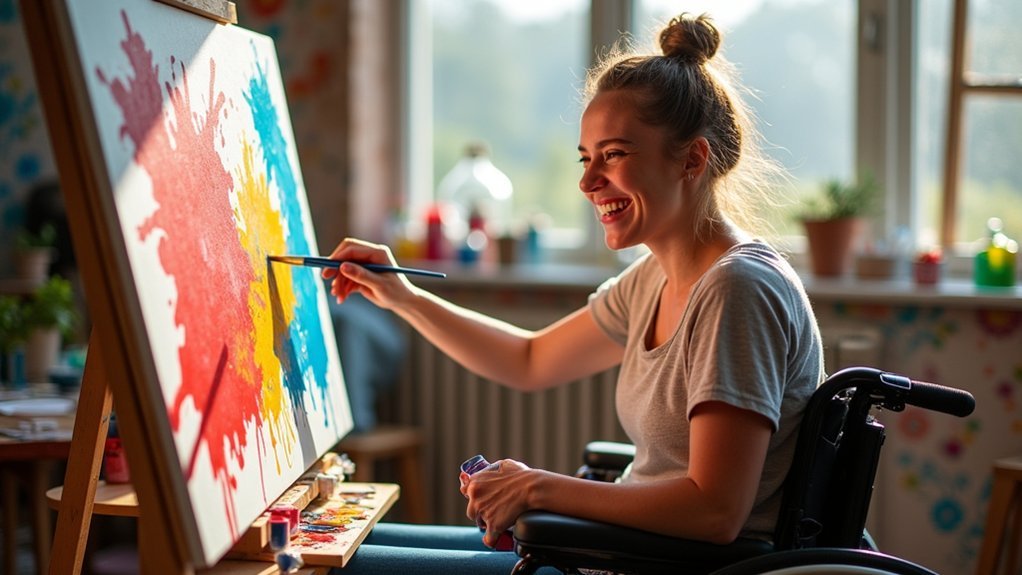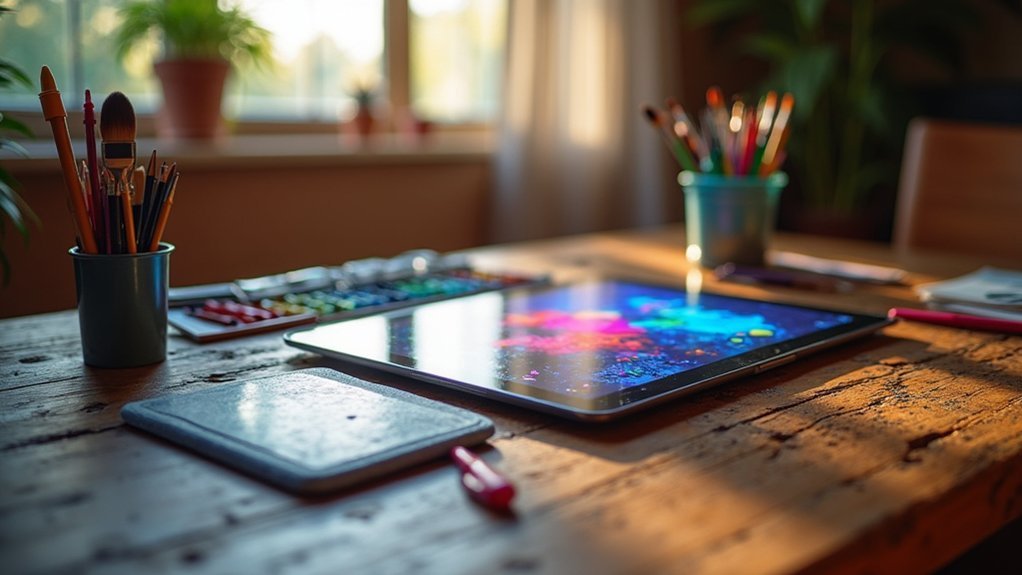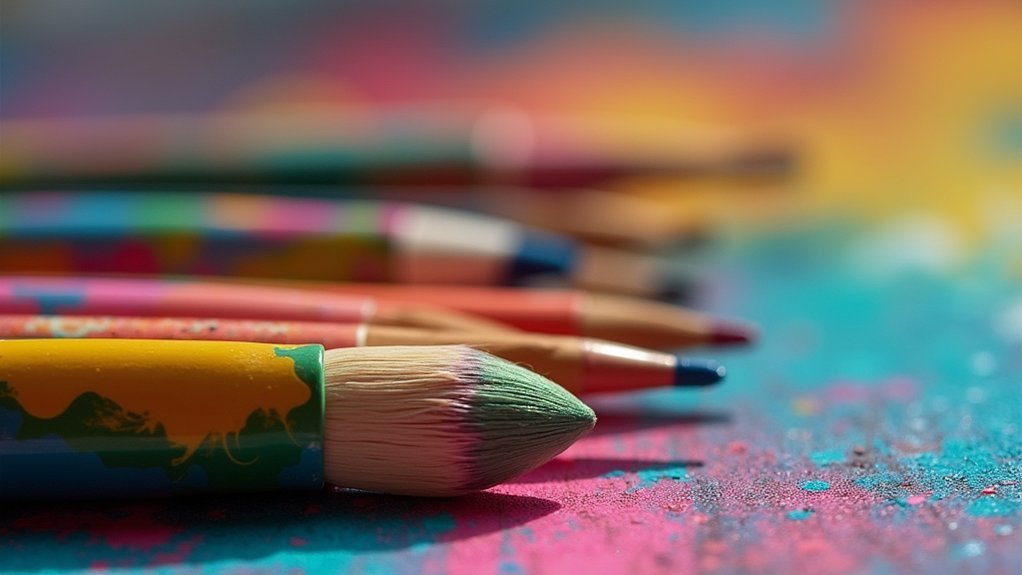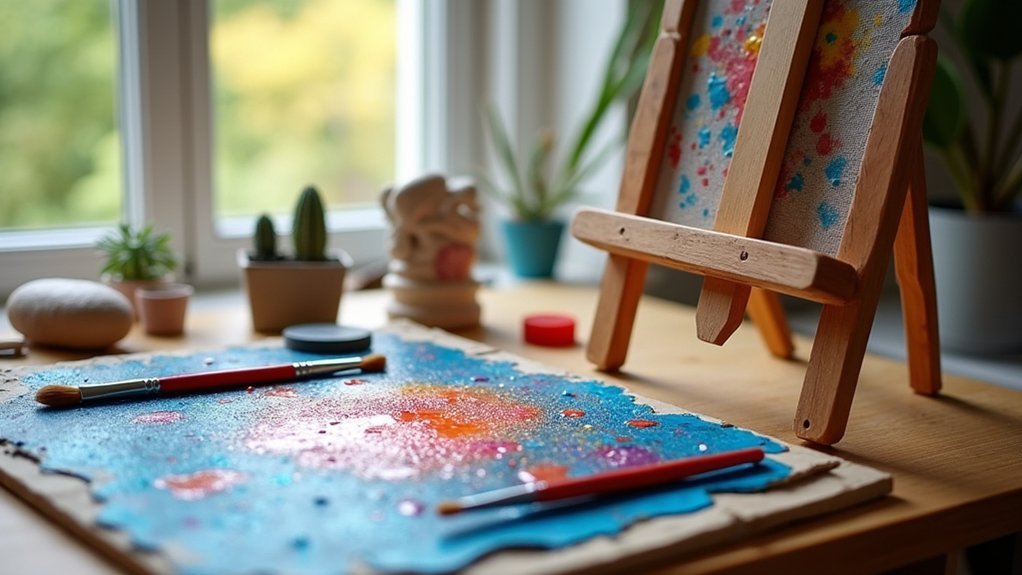Artists with cerebral palsy can now access innovative tools that transform creative limitations into unique expressions. You’ll find wheelchair paintbrush attachments that convert mobility aids into dynamic art tools, adaptive grip handles for better control, and digital platforms with customizable interfaces. Large-scale art tools modify existing equipment while custom-fit brushes accommodate individual mobility patterns. These adaptations don’t just make art possible—they open doors to professional-level artistic expression for creators with diverse physical capabilities.
Wheelchair Paintbrush Attachments: Creating Art in Motion

While traditional artists typically stand at their easels, wheelchair users with cerebral palsy can transform their mobility devices into dynamic artistic tools.
The Mobile Painting Device (MPD) converts wheelchairs into giant paintbrushes, allowing you to create large-scale artwork through precise joystick movements.
Transform your wheelchair into a powerful artistic instrument—create sweeping masterpieces with just the movement of your joystick.
Developed by Jeff Nachtigall in 2007, these attachments apply paint in calligraphic lines, layering colors to build complex pieces. You’ll gain creative freedom and control while expressing your unique artistic style.
The MPD works with various wheelchair models and can be adjusted to suit your preferences.
Beyond individual expression, these innovative tools offer therapeutic benefits, enhancing your well-being and self-esteem. These tools feature adjustable settings designed to accommodate artists with different physical abilities and creative needs.
They also open doors to collaborative projects where multiple wheelchair artists contribute to a single piece, fostering community engagement and social integration.
Adaptive Grip Tools for Enhanced Creative Control
For artists with cerebral palsy, maintaining control over brushes and other tools presents a significant challenge that adaptive grip tools effectively address. Easy-grip brushes with wide handles and functional hand grip aids allow you to hold tools independently despite limited hand dexterity.
You’ll find adaptive scissors designed for simplified cutting tasks and wide grip tools featuring tubular or ball designs that enhance mobility. Many handles can be customized with tape to fit your specific needs and improve control.
Organizations like Zot Artz offer specialized assistive technology that can transform everyday tools—and even wheelchairs—into art-making instruments. These activities are particularly beneficial for individuals with cerebral palsy as they support the development of motor skills and concentration.
These ergonomically designed tools use durable, easy-to-clean materials with thoughtful features like adjustable angles that accommodate your unique abilities, giving you better creative control.
Digital Art Platforms Designed for Limited Dexterity

Digital art platforms open exciting opportunities for artists with cerebral palsy, removing many physical barriers associated with traditional art tools. These platforms integrate accessibility features specifically designed for artists with dexterity challenges, enabling creative expression without physical limitations. Despite technological advances, many artists with upper limb motor impairments still experience significant accessibility barriers when attempting to use standard digital drawing tools.
Digital creativity thrives when technology removes physical limitations, empowering artists with cerebral palsy to express their unique vision.
- Touchscreen devices with intuitive interfaces reduce the need for precise motor control.
- Customizable workspaces let you adjust tool sizes and interface elements to match your abilities.
- Styluses with adaptive grips and ergonomic designs improve control and reduce fatigue.
- Gesture recognition technology translates simple movements into complex artistic techniques.
- Real-time collaboration tools allow you to work with assistants remotely when needed.
With mountable hardware options and adjustable accessories, you can create digital art comfortably from various positions, including wheelchair setups.
Large-Scale Art Tools That Transform Mobility Aids
Transforming mobility aids into artistic platforms, large-scale art tools now enable artists with cerebral palsy to create expansive works without sacrificing comfort or stability.
Your wheelchair can become a dynamic art station with specialized attachments that hold brushes and tools, allowing you to create sweeping motions across large canvases.
Secure palette holders attach directly to your mobility device, keeping paints within reach as you work.
If you use a walker, modifications can transform it into a mobile easel that supports your artistic vision while maintaining stability.
These innovations work with your gross motor movements, turning potentially limiting mobility aids into assets for artistic expression.
The Trabasack Wheelchair Lap Tray provides a sturdy flat surface for artists who need to keep materials secure while creating art from their wheelchair.
Organizations like Zot Artz offer specialized equipment designed specifically for creating impressive large-scale artworks, regardless of your physical capabilities.
Custom-Fit Brushes and Artistic Extensions for Unique Needs

Artists with cerebral palsy can now access custom-fit brushes and extensions tailored to their unique mobility patterns and grip capabilities.
Artistic freedom reimagined through personalized tools that embrace the distinctive movements of creators with cerebral palsy.
These innovative tools feature ergonomic designs with adaptive grips that accommodate different hand types, while artistic extensions like head harnesses enable painting without hand use. The carefully engineered head harness includes adjustable head components derived from safety helmet parts and aluminum tubing for durability and comfort.
You’ll find these tools provide both practical and therapeutic benefits:
- Custom materials selected for your specific artistic needs and preferences
- Adjustable extensions that work seamlessly with wheelchairs and other mobility aids
- Multifunctional attachments supporting various brushes for versatile artistic expression
- Digital interfaces incorporating voice commands and assistive software
- Sensor technology that translates your movements into art, enhancing precision
While costs can be high, financial support is available through government programs, non-profits, and community fundraising.
Frequently Asked Questions
How Much Do Specialized Adaptive Art Tools Typically Cost?
You’ll find specialized adaptive art tools range widely in price: basic tools like switch-adapted scissors cost $80-$215, spin art systems run $90-$150, and custom tool development starts at $450 plus consultation fees.
Can These Art Tools Be Used by Children With Cerebral Palsy?
Yes, these art tools are specifically designed for children with cerebral palsy. You’ll find they’re adapted with easy-grip handles, switch activation, and wheelchair attachments to accommodate different mobility levels and motor skills.
Where Can Artists Find Funding for Expensive Adaptive Equipment?
You’ll find funding for expensive adaptive equipment through nonprofits like VSA, government programs, local grants, private foundations, and crowdfunding platforms. Don’t overlook community fundraising events and corporate sponsorships for additional financial support.
What Training Do Art Therapists Need for Cerebral Palsy Support?
You’ll need a master’s degree in art therapy, training in adaptive techniques, understanding of cerebral palsy, clinical experience with diverse populations, and knowledge of how to collaborate with occupational therapists for effective support.
How Do Seasonal Changes Affect Outdoor Adaptive Art Activities?
You’ll need to adapt your outdoor art activities to each season. Spring offers inspiration from blooming flowers, summer requires shade protection, fall brings colorful leaves for projects, and winter necessitates indoor alternatives.
In Summary
You’ve now seen how these five tools can reveal vast artistic potential for cerebral palsy artists. By embracing these adaptive solutions, you’re able to express yourself without limitations. Don’t let physical barriers define your creative journey. Whether you’re using wheelchair attachments or custom-fit brushes, you’re part of a growing community that’s redefining what’s possible in the art world. Your unique perspective deserves to be shared.





Leave a Reply